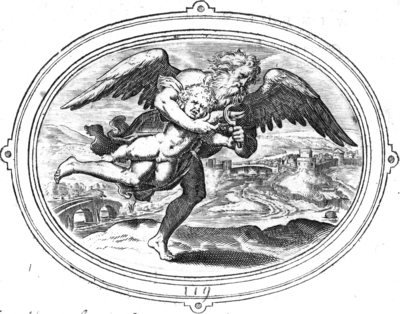Mens immota manet [119]

Translations
 |
[cf. Sambucus p. 72; Giovio, Dial. p. 80]. Vergilius, Aeneis 4, 449.
Zijn besluit staat vast. |
 |
[cf. Sambucus p. 72; Giovio, Dial. p. 80]. Vergilius, Aeneis 4, 449.
Steadfast stands his will. |
Literature
- Henkel and Schöne, Emblemata
 , col. 1815
, col. 1815
- Sebastiàn, Lectura crítica
 , p. 47
, p. 47
Sources and parallels
- Same motto: Whitney, Choice of Emblemes
 , p. 12
, p. 12 -
Parallel for the pictura (background less detailed) and for some mottoes (Latin, Italian, French) in: Le Tems qui tetranche les Ailes à Cupidon (in: Daniel de la Feuille, Devises et emblemes (1691))
[Compare
![Compare [compare]](/static/images/compare2.gif) ]
]
References, across this site, to this page:
- Le Tems qui tetranche les Ailes à Cupidon (in: Daniel de la Feuille, Devises et emblemes (1691))
Iconclass
Time clipping the wings of Cupid- Father Time, man with wings and scythe (+ variant)
[23A1(+0)]

- river
[25H213]

- landscape with bridge, viaduct or aqueduct
[25I6]

- running
[31A27112]

- being carried
[31A2733]

- Youth, Adolescence, 'Iuventus'; 'Adolescenza', 'Gioventù' (Ripa)
[31D120]

- agricultural implements: sickle
[47I15(SICKLE)]

- Immutability (+ emblematical representation of concept)
[51KK2(+4)]

- (personifications and symbolic representations of) Love; 'Amore (secondo Seneca)' (Ripa) (+ emblematical representation of
concept)
[56F2(+4)]

- proverbs, sayings, etc. (with TEXT)
[86(MENS IMMOTA MANET)]

- suffering, misfortune of Cupid
[92D16]

![[H O M E : Emblem Project Utrecht]](/static/images/rd-small.gif)


















































































































































